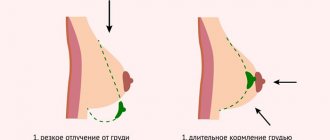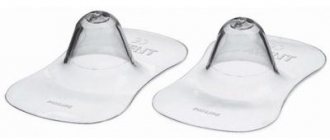Exercises
How to preserve breasts after feeding? The effect of physical activity on breast tissue is often underestimated. But it is precisely this that is the best way to tighten your bust.
Useful for breast shape correction:
- Push ups . The exercise is performed in a classic form or with support on the knees. Two approaches of 10 times, you can start with a smaller amount, gradually increasing it.
- Palms in front of chest . Squeeze your palms, keeping them parallel to your chest area, for a few seconds. Relax your arms and repeat the exercise. Repetition frequency – up to 30 times.
- Palms behind the back of the head . Place your palms behind your head and squeeze, performing the same as the previous exercise.
- Exercises with dumbbells . Lying on your back and bending your knees, pick up dumbbells weighing 2 kg each. If you don't have them, you can take water bottles. Bend your elbows, then straighten them above your chest and return to the starting position. Perform 3-4 approaches 10 times. You can supplement the exercise by raising your arms straight, slightly bent at the elbows to the sides, the number of repetitions is the same.
- Exercises with the ball . Stand in front of a wall straight, with your feet shoulder-width apart. Throw the ball at the wall and catch it, making sure your hands remain at chest level. Repeat 50 times. You can do the exercise with a partner.
If you haven't finished breastfeeding yet, it's best to do exercises after your baby has eaten. With an “empty” chest, physical activity is easier.
Natural Changes
During pregnancy, a woman's breasts undergo significant changes. From the first days until birth, the mammary glands are actively prepared for breastfeeding. The breasts increase significantly in size at this time. Nipples darken.
Shortly before giving birth, a clear liquid called colostrum may begin to be released from the mammary glands. These are the first priceless drops of nutrition for the little man. After the birth of the baby, milk begins to arrive on days 3-5.
As a rule, with full natural feeding and gradual cessation of lactation, the breasts, after completion of feeding, take their original shape. However, there are frequent cases of stretch marks and loss of breast shape after childbirth. This frightens many expectant mothers, because for many of them women’s breasts are a source of pride, and they do not want to lose their beauty. Let's look at the most common changes in the appearance of the breasts that expectant mothers are afraid of.
Stretch marks can appear in a woman during pregnancy. Most often this phenomenon can be observed during the first pregnancy. The causes of this skin defect are hormonal changes and a sharp enlargement of the mammary glands. With the onset of pregnancy, a woman's hormonal background changes, as a result of which the skin becomes thin and vulnerable. Rapid stretching of the skin during breast enlargement can be accompanied by tears in the inner layers of the skin, which causes the appearance of red stretch marks. Stretch marks during pregnancy can appear not only on the chest, but also on the stomach, as well as on the hips of the expectant mother.
Care rules to maintain shape
It is easier to prevent any physiological changes than to deal with their consequences. And cases where breasts sag after childbirth are no exception. It is for this reason that every woman should know how to avoid such problems and what measures should be taken to achieve this.
Will artificial feeding help?
Many representatives of the fair sex do not plan to breastfeed even before pregnancy, because they are completely sure that it is the lactation process that leads to sagging breasts and changes in their shape. But it is not so. Before you give up breastfeeding and immediately after birth transfer your baby to artificial feeding, you should weigh the pros and cons. Everyone knows that breastfeeding is much healthier than formula. Breast milk contains many more nutrients, but the most important thing is that with it the baby receives reliable immune protection from the mother. Artificial feeding can never 100% replace mother's milk. So is it worth giving up natural lactation in order to preserve breast shape, and is this method effective?
Whether the breast remains in its original form or sag directly depends on its original size, as well as on how much milk arrives in it. Even if a woman refuses to feed, and milk arrives in the glands, the above problems in the form of sagging, the appearance of venous networks and stretch marks cannot be avoided in any case. It is possible to maintain the breast shape in ideal condition only if there is little milk or it does not arrive at all. Even if a woman refuses to breastfeed, and there is a lot of milk, she will need to take certain measures and wait until the milk disappears. During this time, as well as after enlargement during pregnancy, the breasts will change their shape, and giving up breastfeeding will not benefit either the mother or the child.
A bra that protects beautiful shapes
Especially for women who plan to breastfeed, numerous manufacturers produce support bras for sale. Representatives of the fair sex who have experienced their effectiveness call such wardrobe items a real salvation. Wearing an elastic support bra is necessary not only during breastfeeding. If you plan to maintain the shape of your breasts and their elasticity, you need to purchase a special bra. This should be done already during pregnancy. The next stage is the feeding period. The end of wearing a support bra is a few months after you stop breastfeeding.
It is necessary to wear special underwear for pregnant and nursing mothers not only during the day, but also at night. To ensure that the breasts remain in their original shape. The special shape of the bra for pregnant and nursing mothers ensures comfort. The main thing is to choose the right size. It is important that such underwear does not rub or strongly compress the breasts and is equipped with wide straps, which, like the bodice, play an important role in maintaining the shape of the breasts. It is advisable that the cups have special inserts that allow you to feed the baby without removing the bra.
Particular attention should be paid to the selection of a specific model. The following should be taken into account:
- Compound. It is desirable that natural materials predominate in the composition. It is better if it is cotton, the percentage of which should not be lower than 60%. The rest is allocated to elastic synthetic material, which will help support the breasts and prevent the underwear from deforming during washing.
- Cup. It can be with a secret (a detachable insert) and can be completely unfastened from the strap during feeding. The composition should be pleasant to the touch and not cause irritation. There should be no underwires or foam inserts in the cup of a special nursing bra.
- Clasp. Can be located in front or behind. It is important that it includes at least 3 rows of hooks. This will allow you to adjust the size of the product depending on the increase or decrease in breast shape.
- Straps. They should not only be elastic and as wide as possible. It is important that they stretch well and are adjustable in size, since the constitution of each woman is individual.
You should not give up special support bras immediately after a woman stops breastfeeding. This is a common mistake many mothers make. It is important to wear such a bra for at least several months after the cessation of lactation. If necessary, you should change its size and adjust the straps.
How to deal with stretch marks
Unfortunately, if the defect is already present on your skin after childbirth, it is almost impossible to get rid of it on your own. Using creams and ointments for stretch marks will only help make the defect less noticeable. In order to permanently get rid of existing scars, plastic surgery or laser treatment is necessary. Fortunately, the risk of stretch marks can be reduced or eliminated altogether. To do this, from the very beginning of bearing a baby, you need to pay increased attention to your body.
First, you need to monitor your weight. During pregnancy, a woman should gain no more than 14 kg in weight for a singleton pregnancy. To control your weight, you need to undergo regular weighings with a gynecologist before giving birth. If the doctor notes that you have gained excess kilograms, you must strictly follow the doctor’s recommendations to avoid obesity.
Secondly, you need to take care of your skin. Regular moisturizing using special oils and creams during pregnancy and after childbirth will give your skin elasticity, which means it can stretch without damage.
Thirdly, before giving birth, watch your diet. In order for the skin to receive all the necessary vitamins and microelements, to be strong and elastic, you need to eat a lot of vegetables, herbs and fruits. Cabbage is especially useful during pregnancy. It contains a large amount of fiber, which protects the breasts from many diseases.
Lingerie during pregnancy
Comfortable underwear should become every woman's companion throughout pregnancy and lactation. Special models of bras, developed taking into account the needs of women during this period, will help maintain the breasts in a normal position, preventing sagging and without squeezing the mammary glands.
Give preference to bras with wide straps and a special window for feeding.
Remember that underwear during pregnancy and breastfeeding should be made from natural fabrics. The bra must be selected exactly according to your breast size. With the enlargement of the mammary glands, it is necessary to purchase new underwear in a larger size.
Proper organization of lactation
To ensure that the skin of the mammary glands remains elastic, it is important to pay attention to the basic rules of breastfeeding:
- You need to put your baby to your breast regularly and not leave long gaps. This is useful not only for the health of the little one, but also for the condition of the mammary gland. Due to an excess of milk, it can stretch, and the skin becomes flabby after lactation.
- You shouldn’t pump until the last drop after every feeding. Milk will begin to flow more actively, but this will not force the baby to eat with increased appetite. Pumping leads to damage to delicate tissues, and the skin loses its elasticity due to regular trauma.
- It is bad if the baby is pinched or scratched while feeding. When a comfortable position is found, he will feel good and will not be distracted, injuring his chest. If this has become a bad habit, then the little one’s hands can be occupied with a toy or special beads can be used during feeding.
- The cessation of lactation should not be abrupt. You need to consult a doctor on how to wean your baby off the breast correctly so that this process is painless for the female body. You will need to gradually reduce the number of feedings per day, replacing them with regular food. Your doctor can show you how to properly bandage your breasts to prevent stretching. If necessary, hormonal drugs that inhibit milk production can be prescribed. In this case, the glandular tissue of the breast is converted into fat, and the skin cells are reduced. The mammary gland returns to its previous shape.
- It is extremely important to pay attention to the sensations in the chest area. When health is normal, the period of lactation or its completion is not accompanied by painful manifestations. Therefore, you need to undergo a timely examination by a mammologist if you experience a feeling of discomfort or dense formations in the mammary gland that do not disappear for a long time. An alarming sign is also an increase in body temperature.
Experts say that it is the lactation period that has a positive effect on the health and attractiveness of the breasts. To ensure breastfeeding goes well, it is important to pay attention to even such little things as your mood or a comfortable place for feeding. This will help establish normal milk flow, lymph movement and maintain cell tone. Then pregnancy and breastfeeding, which lasts more than a year, will not interfere with keeping your breasts beautiful.
How to feed?
– First, choose a bra for yourself, it should be a model that is comfortable for you, the straps must be wide, and the size must match yours. You should not take it off in the last months of pregnancy and during feeding, only at night you can wear a more spacious one.
– Manual expression also stretches the breast; if the baby is unable to suck out the milk completely, use a breast pump.
– Do not allow the milk to stagnate.
– The amount of milk should be approximately the same in each breast. To do this, change breasts during feeding, put the baby on both, and start the next feeding with the breast that you finished the previous feeding with.
– Before night feeding, both breasts must be completely emptied of milk.
go to top
Why do breasts change?
Breasts lose shape not only due to pregnancy and breastfeeding; even women who have not given birth can experience changes that are not for the better with age. This can be influenced by the following factors: heredity, sudden changes in weight, for example sudden weight loss or sudden weight gain, smoking. If you always want to remain with beautiful breasts, you should take care of this before the time you decide to become a mother. If you regularly perform special exercises, you will be able to maintain the shape of your breasts with virtually no changes.
go to top
How to maintain breast shape while breastfeeding?
Breastfeeding and breast shape
Breasts are one of the most beautiful parts of a woman's body. Breasts serve as a symbol of female beauty and sexuality. Breasts have always been admired by poets, writers and artists. Every woman's breast is unique and beautiful. She is worthy of love and admiration. It is a woman’s attitude towards her breasts and her entire body that determines how happy a woman is in her personal and, oddly enough, in public life. A woman who is happy with her body feels confident and loved and is ready to give these feelings to the whole world. Any breast needs care and respect for it, regardless of shape and size. Love your breasts for who they are and never compare your breasts to someone else's.
Women have a large number of fears about the size and shape of their breasts. The most common of them are related to breastfeeding.
For example, if the size of the mammary gland is small, will it be able to produce enough milk to feed the child? Or how will the shape of the breast change after breastfeeding ends? Will she remain as beautiful?
In order to dispel these fears, you need to know how the mammary gland works.
Each mammary gland is located on the anterior surface of the chest, lying on the pectoralis major muscle. Each mammary gland consists of adipose tissue and glandular tissue. It is the amount of adipose tissue that determines the size and volume of the mammary gland. Glandular tissue is responsible for milk production. The amount and structure of glandular tissue in all women is approximately the same. Therefore, any woman, absolutely any, will be able to feed her child with breast milk.
Special septa divide the breast tissue into separate lobes and segments, which include both glandular and adipose tissue.
The glandular tissue of the mammary gland is formed by individual glands; they are shaped like a bunch of grapes. When milk is formed in the glands, it flows through the milk ducts into the milk sinuses. And the milk sinuses open on the nipple with several holes.










